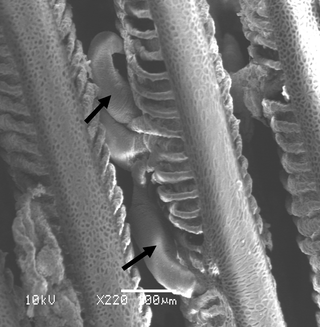
Pseudorhabdosynochus is a genus of monopisthocotylean monogeneans, included in the family Diplectanidae. The type-species of the genus is Pseudorhabdosynochus epinepheli .
Pseudorhabdosynochus auitoe is a diplectanid monogenean parasitic on the gills of the Highfin grouper, Epinephelus maculatus. It was described in 2007.

Pseudorhabdosynochus malabaricus is a diplectanid monogenean parasitic on the gills of the malabar grouper, Epinephelus malabaricus. It has been described in 2007.

Pseudorhabdosynochus maaensis is a diplectanid monogenean parasitic on the gills of the malabar grouper, Epinephelus malabaricus. It has been described in 2007.

Pseudorhabdosynochus marcellus is a diplectanid monogenean parasitic on the gills of the malabar grouper, Epinephelus malabaricus. It was described in 2007.

Pseudorhabdosynochus manipulus is a diplectanid monogenean parasitic on the gills of the malabar grouper, Epinephelus malabaricus. It was first described in 2007.

Pseudorhabdosynochus caledonicus is a diplectanid monogenean parasitic on the gills of the Blacktip grouper, Epinephelus fasciatus. It has been described in 2005.
Pseudorhabdosynochus amplidiscatus is a diplectanid monogenean parasitic on the gills of groupers. It was described as Diplectanum amplidiscatum by Bravo-Hollis in 1954 and transferred to the genus Pseudorhabdosynochus by Kritsky and Beverley-Burton in 1986.
Pseudorhabdosynochus venus is a diplectanid monogenean parasitic on the gills of the grouper Epinephelus howlandi. It has been described in 2006.
Pseudorhabdosynochus satyui is a species of diplectanid monogenean that is parasitic on the gills of the Hong Kong grouper. It was described in 2009.
Pseudorhabdosynochus stigmosus is a species of diplectanid monogenean that is parasitic on the gills of the brownspotted grouper Epinephelus chlorostigma. It was described in 2010.
Pseudorhabdosynochus chinensis is a species of diplectanid monogenean parasitic on the gills of the greasy grouper, Epinephelus tauvina. It was described in 2001.
Pseudorhabdosynochus cupatus is a species of diplectanid monogenean parasitic on the gills of groupers.

Pseudorhabdosynochus lantauensis is a diplectanid monogenean parasitic on the gills of the longtooth grouper, Epinephelus bruneus. It was described in 1981 as Cycloplectanum lantauensis and later transferred to the genus Pseudorhabdosynochus by Kritsky & Beverley-Burton in 1986.
Pseudorhabdosynochus melanesiensis is a diplectanid monogenean parasitic on the gills of the grouper, Epinephelus merra. It was described in 1958 as Diplectanum melanesiensis then transferred to the genus Pseudorhabdosynochus by Kritsky & Beverley-Burton in 1986.
Pseudorhabdosynochus serrani is a species of diplectanid monogenean parasitic on the gills of a fish. It was described in 1953 by Satyu Yamaguti as Diplectanum serrani and later transferred to the genus Pseudorhabdosynochus. The species has been redescribed in 2005.
Pseudorhabdosynochus shenzhenensis is a species of diplectanid monogenean parasitic on the gills of the grouper Epinephelus coioides. It was described in 2005.
Pseudorhabdosynochus summanoides is a species of diplectanid monogenean parasitic on the gills of the orange-spotted grouper Epinephelus coioides. It was described in 2005.
Pseudorhabdosynochus summanae is a species of diplectanid monogenean parasitic on the gills of the grouper Epinephelus summana. It was described in 1969, from only four specimens, under the name Diplectanum summanae and transferred to the genus Pseudorhabdosynochus in 1986.
Pseudorhabdosynochus querni is a species of diplectanid monogenean parasitic on the gills of the grouper Epinephelus quernus. It was described in 1968 by Satyu Yamaguti under the name Diplectanum querni and transferred to the genus Pseudorhabdosynochus in 1986. The species has been redescribed in 2005 from the type-material.









